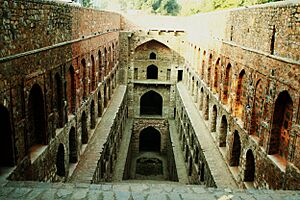Agrasen facts for kids
Quick facts for kids Agrasen Maharaj |
|
|---|---|
| Chattrapati | |
| Predecessor | Maharaja Vallabh |
| Successor | Vibhu |
| Consort | Madhavi |
| Issue | Vibhu |
| Dynasty | Suryavanshi |
| Father | Maharaja Vallabh |
| Mother | Bagwati Devi |
Agrasen was a legendary Indian king. He ruled a city of traders called Agroha. People remember him for starting a kingdom of traders in North India. He was also known for his kindness. He refused to harm animals during religious ceremonies called yajnas.
A goddess named Mahalakshmi suggested something important to him. She told him to change from the `Kshatriya` (warrior) way of life to the `Vaishya` (trader) way. She promised that if he did, his city and his family would become very rich and successful.
In 1976, the Government of India honored King Agrasen. They released a special postage stamp with his picture on it.

How We Know About Agrasen
The stories about King Agrasen became widely known because of an essay written in 1871. This essay was called Agarwalon ki Utpatti. It was written by a famous Agrawal author and poet named Bharatendu Harishchandra.
He said he gathered these stories from old traditions and ancient writings. One important text he mentioned was Sri Mahalakshmi Vrat Ki Katha. This text was supposedly part of a larger ancient book called the Bhavishya Purana.
Later, in 1976, an Agrawal historian named Satyaketu Vidyalankar found a copy of Mahalakshmi Vrat Ki Katha. He said he found it in Bharatendu Harishchandra's own library.
Agrawal Family Groups
According to Bharatendu Harishchandra's stories, the Agrawal community has many different family groups. These groups are called gotras. There are said to be seventeen and a half of these groups.
The story says these groups came from seventeen and a half special ceremonies. King Agrasen performed these ceremonies. The last ceremony is called "half" because Agrasen stopped it early. He felt bad about the animals that were being sacrificed.
Historically, people have not always agreed on the exact number or names of these family groups. There are some differences depending on the region. In 1983, a big Agrawal organization tried to create a standard list. However, this list has been debated by some people.

